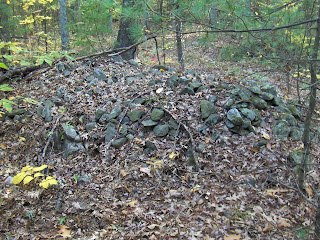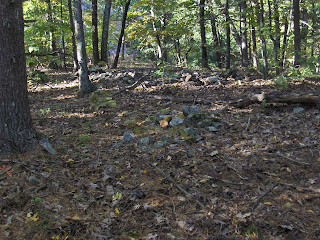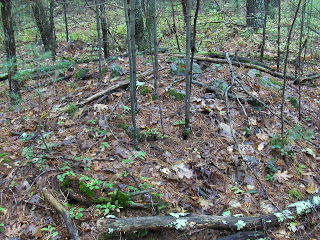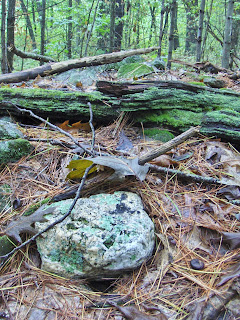Sunday, October 30, 2016
Saturday, October 29, 2016
Tuesday, October 25, 2016
"Well Formed Openings"
I've really been paying attention to those "well constructed wall openings" mentioned here ever since finding the snake head-like boulder shown above, with that well defined white quartz eye feature, at the land trust property around former home of the first Puritan minister in Bethlehem CT. The boulder on the opposite side of the gateway also could be said to resemble another snake head-like stone and both are at slight angles as if giving the impression that the snakes are looking at whom-ever is entering this gateway, bringing to mind that the word Uktena literally means "Strong Looker." The next "well formed opening" to the north of the one shown above at first glance doesn't appear to be anything remarkable as you approach it:
Standing in the center of the opening, looking to the left, one could interpret this as a variation of the serpent theme, using flatter stones obviously (stacked on what may be an older serpent below the uppermost):
Turning to the right, an almost identical stone, possibly disturbed a little, but still conveying the impression (the Indigenous builder's purposeful intention) of an Uktena seeming to look at the person entering the gateway:
Peter's post about Sawyer Hill featured this photo:
Side by side, my photo and Peter's, cropped just a little and resized for effect:
I don't know what sort of "space" these serpents shown above protect (thinking of Denison Peet and serpents that guard agricultural fields http://wakinguponturtleisland.blogspot.com/2015/02/effigies-as-source-of-protection-to.html), but these in this post show a repeat of that sort of pattern as "well formed entrances" into a cranberry "swamp" in Litchfield CT, about 10 miles north of the Preacher's Preserve: http://wakinguponturtleisland.blogspot.com/2016/04/cranberry-garden-edge.html
Monday, October 24, 2016
Camp of the Sacred Stones (ND)
On Saturday (Oct. 22, 2016), hundreds of
water protectors from different nations were met with violence by militarized
police in riot gear, and approximately 141 were arrested. Four protectors
locked themselves to a disabled car at an active construction site, stopping
construction for approximately 7 hours. Then a peaceful procession of hundreds
walked to the sacred sites intentionally destroyed by Dakota Access LLC on
September 3rd.
Photo by Rob Wilson Photography
LaDonna Allard, a
Standing Rock Sioux tribal member who founded the Sacred Stone Camp, spoke of
the sacred sites people are trying to protect: “There are sacred sites,
cultural sites, traditional cultural properties, and burial sites that the
State Historical Society knew of - they should've followed the law and must
protect these sites. But they are pushing the sites under the rug and no one is
talking about it. There's the executive order protecting sacred places - E.O.
130007, NAGPRA, ARPA, and the NHPA that are supposed to protect these sites.
AIRFA is supposed to give Natives the right to visit these places. To the North
Dakota SHPO: just because you accepted the money from the oil company does not
mean you have the right to violate our rights. No one has the right to take our
footprint off the earth."
“This gathering has been called the largest gathering of
Native Nations ever...” http://theindigenouspeople.com/2016/10/04/feds-shoot-down-furious-north-dakota-cops-and-dapl-corp-telling-them-there-are-no-grounds-to-evict-growing-pipeline-protest-camp/
Images perhaps similar to those bulldozed sites near Camp Standing Rock and a link to the DemocracyNow! coverage from 9/6/2016:
http://wakinguponturtleisland.blogspot.com/2016/09/stone-piles-snakes-and-turtles-in-n.html"Petroglyphys" from Pinnacle Mountain
Reader Gene sends:
All the circles are not truly "circles". I'm trying to re educate our people to use the term in Goodlett's dissertation : pecked curvilinear nucleated. Ok, circles is easier! We believe the intent of the carver was to carve circles, but have u ever tried to carve granitic gneiss with a rock?
In the 2500+ motif's we've looked at, there was one "possible" square and one suspect triangle.
In the last 15 yrs we have locate 15 or sites in SW North Carolina and NW South Carolina that contain only pecked circles. In one case, over 600 of them! In all, we have located app 2500 carved circles in SC and 300+ in NC.
All sites carved in granitic gneiss, and all except two, above 2000 ft elevation. They closely resemble Pecked Curvilinear Nucleated glyph's as described by Gillette in her PhD thesis in CA; none of ours exhibit the prominent dome in the center of the circle.
All the circles are not truly "circles". I'm trying to re educate our people to use the term in Goodlett's dissertation : pecked curvilinear nucleated. Ok, circles is easier! We believe the intent of the carver was to carve circles, but have u ever tried to carve granitic gneiss with a rock?
In the 2500+ motif's we've looked at, there was one "possible" square and one suspect triangle.
Sunday, October 23, 2016
Fall arrowhead season
Many sites, where I once found arrowheads, have been destroyed. I have spent a lot of time this fall searching in new places. I haven't found anything.
I drove by a familiar place. The conditions looked terrible- a disappointment. I kept going, but after a while I turned around. There were some small spots there, where the ground was exposed, and where I could look. Maybe worth taking a short walk, get out of the car, stretch my legs a little.
I parked my car on the road. I took a few steps. I was about 5 feet from the pavement and had been out of the car for less 10 seconds, when I saw this.
I could not believe my own eyes. Usually, for me, looking for arrowheads entails long hours of pacing back and forth, sometimes finding something, more often finding nothing. There have been a few times that I have found something almost right away but this particular find is a new record for me, I think. I wonder how many stone tools are under that road? How many people, driving there, would ever suspect?
I drove by a familiar place. The conditions looked terrible- a disappointment. I kept going, but after a while I turned around. There were some small spots there, where the ground was exposed, and where I could look. Maybe worth taking a short walk, get out of the car, stretch my legs a little.
I parked my car on the road. I took a few steps. I was about 5 feet from the pavement and had been out of the car for less 10 seconds, when I saw this.
I could not believe my own eyes. Usually, for me, looking for arrowheads entails long hours of pacing back and forth, sometimes finding something, more often finding nothing. There have been a few times that I have found something almost right away but this particular find is a new record for me, I think. I wonder how many stone tools are under that road? How many people, driving there, would ever suspect?
This is, in my opinion, a good example of this type of projectile point. Squibnocket Stemmed, I would call it. The material is quartz, as usual. A typical shape and material for southeastern New England.
I found some other items that afternoon. This one was easy to spot.
Not as nice as the first one but still a decent point, I think.
It was a good day!
A different day, in the same place.
It's a Squibnocket Triangle. I don't know why the people who lived in this spot used quartz so much, and almost never any other material. This little guy is rather well made. The person who made it had skill.
It rained this weekend. Maybe I will go back to this place.
Friday, October 21, 2016
Sachem Hill Photos
A reader writes:
thought you may be interested in photos of Sachem hill at sachemhill.blogspot.com.
Because it is a new site I haven't figured out how to have comment boxes without them being under every photo and that is jarring. I welcome you expertise and feedback if you are so inclined.
thought you may be interested in photos of Sachem hill at sachemhill.blogspot.com.
Because it is a new site I haven't figured out how to have comment boxes without them being under every photo and that is jarring. I welcome you expertise and feedback if you are so inclined.
NEARA fall meeting in Billerica MA
Peter Anick of NEARA writes:
Hoping to see a lot of our Massachusetts members at the Billerica NEARA conference next weekend (Oct. 28-30).
Hoping to see a lot of our Massachusetts members at the Billerica NEARA conference next weekend (Oct. 28-30).
Thursday, October 20, 2016
If you have a hypothesis then every observation is an experiment
So the hypothesis is that mounds are found at brook headwaters. The experiment is: go to a headwater and look for a mound. If you find one then it confirms the hypothesis.
I did this over and over and it worked, even in impossible towns like Groton and Lunenburg. So I hope the hypothesis is well enough confirmed that some functional relation between brooks and mounds is needed in order to explain the correlation.
Putting aside, for a moment, that the particular kind of mounds found there at headwaters tend towards the rectangular with collapsed inner structure: Why near a brook?
There is a tendency to consider site location a matter of "spiritual energy", coming from the natural composition of elements of sky and water (as Mavor and Dix wrote) but perhaps containing something more.
But consider: brooks are means of transporting objects. The object could be people or it could be something else. I propose that if it was just people, you would not need to be near a brook.
I did this over and over and it worked, even in impossible towns like Groton and Lunenburg. So I hope the hypothesis is well enough confirmed that some functional relation between brooks and mounds is needed in order to explain the correlation.
Putting aside, for a moment, that the particular kind of mounds found there at headwaters tend towards the rectangular with collapsed inner structure: Why near a brook?
There is a tendency to consider site location a matter of "spiritual energy", coming from the natural composition of elements of sky and water (as Mavor and Dix wrote) but perhaps containing something more.
But consider: brooks are means of transporting objects. The object could be people or it could be something else. I propose that if it was just people, you would not need to be near a brook.
I had a nice experience - East branch of North Brook, Berlin
Here is the nice experience: standing about where the blue dot appears on the map in that saddle, I was planning my route - looking off to the southwest and thinking about going down in there. Thinking...."OK if I am going down in there, is there anything up here to look at first before I go down there? What about the highest headwaters to the left here and behind me?" So I turned around and there was a small rock pile right there:
Solitary rock piles don't tell you much. So I looked carefully in one direction and around and back in another and saw a kind of bump with growth blocking it from view. Then, what d'ya know? Something bigger:
Some other views:
Upper surface
There is internal structure there but not obvious hollows. Except for that vagueness this larger 'mound' has all the attributes typical rock piles found where brooks begin. In this case it is the east branch of North Brook in Berlin.
I did not find much else on the walk. I have been taking it easy lately and did not go down into the valley because it was too overgrown. I did notice that this site, with the mound and smaller 'satellite' pile, was adjacent to a well constructed wall opening. With reference to what I was writing here, these openings are inviting and have been useful guides:
You can sense the larger mound in the center background of this picture:
The smaller pile is off through this opening to the left about 30 feet.
For what it is worth, when I climbed back up to Sawyer Hill Rd from the east, I crossed the road and saw some broken down piles on the crest of the ridge, almost in someone's backyard:
These are as important as anything else, just harder to see.
Wednesday, October 19, 2016
Wednesday, October 12, 2016
Bye bye to the Stow Grid at Gates Lane?
They started digging there, in Stow. Here is what will be lost.
My sketch, with paces and occasional compass bearings:
My sketch, with paces and occasional compass bearings:
This site, on a flat slope, is THE classic marker pile site.
Here is the obligatory rectangle with hollow (I think):
It might be a burial and the site revolves around it. Why is it so hard to get NAGPRA applied?
Tuesday, October 11, 2016
Friday, October 07, 2016
Hunting for rock piles, from southern Estabrook, over to Boaz Brown's
See map in previous post. A brook called "Dakins Brook" leads up past Farmer's Cliff and begins in a valley just shy of "Mink Pond". Please note this valley and the higher ground to the west which is where Boaz Brown's cellar hole is found (on a path 100 yards east of Hugh Cargill Rd.). That valley and land form have more rock piles sites than anywhere else in Concord. There are what I consider to be burial mounds up on the ridge (rectangular, more than 8 feet across, with hollows), and some very nice piles down in the valley, that are a bit unique.
I have been to these places before but, even without that, exploring a ridge west of a headwaters is a good hunting strategy. Last Sunday, I wanted to take a walk near home, and went out with my wife, and followed that strategy, around the edges of the open "private" land and roads. So I ended up walking along the edge of that ridge: I mean here:
We got up on the ridge slightly south of where the good stuff starts (not realizing where we were) and I saw a couple of structures that were new:
I cannot make out much from these. You will have to look quite closely to see how the above is slightly rectangular, with a space to the left of the larger rock (a "lazy 9". Below, you can see two hollows in the structure, but I do not trust it. It is so degenerate.
I guess they are older structures. Overall, there are about six mounds, possibly burials, up on that northern piece of the above map.
Then we came to a "real" rock pile:
I started wondering if we were over at Boaz Brown's. We were. And there are all kinds of peculiar rock piles on bedrock, along with short stretches of stone wall. Enough to make you wonder, what was Boaz Brown up to?
Here are two holes, that must be the "cellars":
Since the above rock piles are rather unusual and in the context of a historic period home, it is easy to suppose they are not Indian and not ceremonial.
However the visibility into the undergrowth was very good. It was cloudy, these woods are sparse, and I spotted something new. This seems undeniably ceremonial. It is a triangle:
And it has a white blaze:
It is a light tan feldspar:
Triangular mounds are rare. I know one in Wayland and one in Sterling (the one in Wayland is bigger, likely different).
Here is the trail in from Hugh Cargill Rd:
The triangular mound is immediately to the left in the saplings. The cellar holes are a few steps later on the right, and the other piles continue to the left. So Boaz Brown was looking out at this triangular mound from his front door. He knew it was there.
I have been to these places before but, even without that, exploring a ridge west of a headwaters is a good hunting strategy. Last Sunday, I wanted to take a walk near home, and went out with my wife, and followed that strategy, around the edges of the open "private" land and roads. So I ended up walking along the edge of that ridge: I mean here:
We got up on the ridge slightly south of where the good stuff starts (not realizing where we were) and I saw a couple of structures that were new:
I cannot make out much from these. You will have to look quite closely to see how the above is slightly rectangular, with a space to the left of the larger rock (a "lazy 9". Below, you can see two hollows in the structure, but I do not trust it. It is so degenerate.
I guess they are older structures. Overall, there are about six mounds, possibly burials, up on that northern piece of the above map.
Then we came to a "real" rock pile:
I started wondering if we were over at Boaz Brown's. We were. And there are all kinds of peculiar rock piles on bedrock, along with short stretches of stone wall. Enough to make you wonder, what was Boaz Brown up to?
Here are two holes, that must be the "cellars":
Since the above rock piles are rather unusual and in the context of a historic period home, it is easy to suppose they are not Indian and not ceremonial.
However the visibility into the undergrowth was very good. It was cloudy, these woods are sparse, and I spotted something new. This seems undeniably ceremonial. It is a triangle:
And it has a white blaze:
It is a light tan feldspar:
Triangular mounds are rare. I know one in Wayland and one in Sterling (the one in Wayland is bigger, likely different).
Here is the trail in from Hugh Cargill Rd:
The triangular mound is immediately to the left in the saplings. The cellar holes are a few steps later on the right, and the other piles continue to the left. So Boaz Brown was looking out at this triangular mound from his front door. He knew it was there.
Subscribe to:
Comments
(
Atom
)






















































